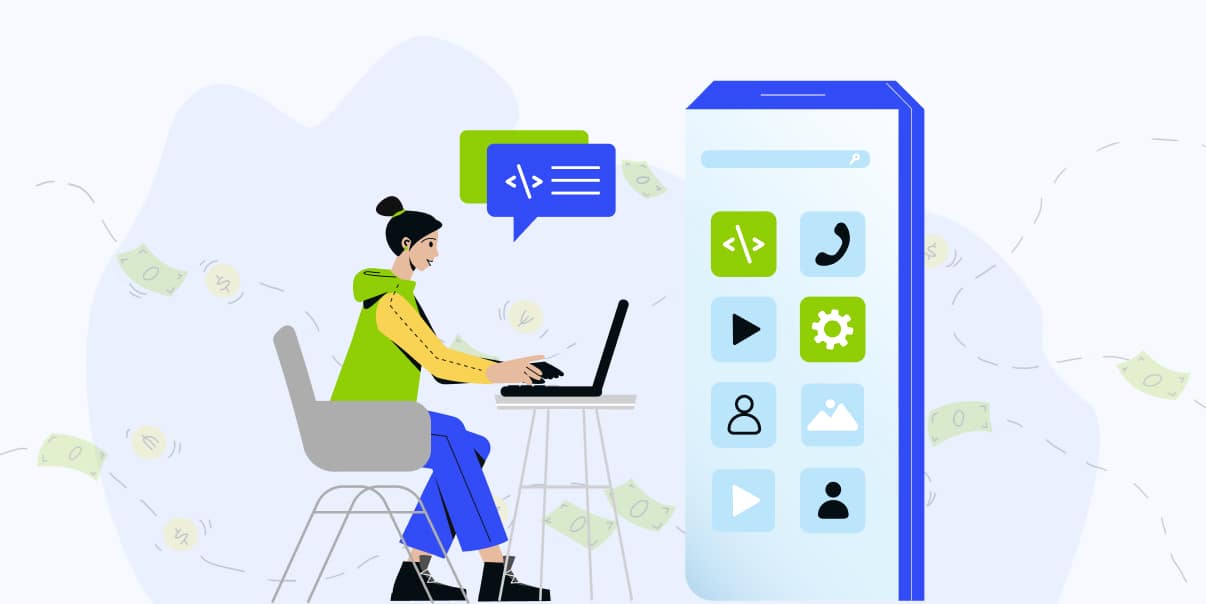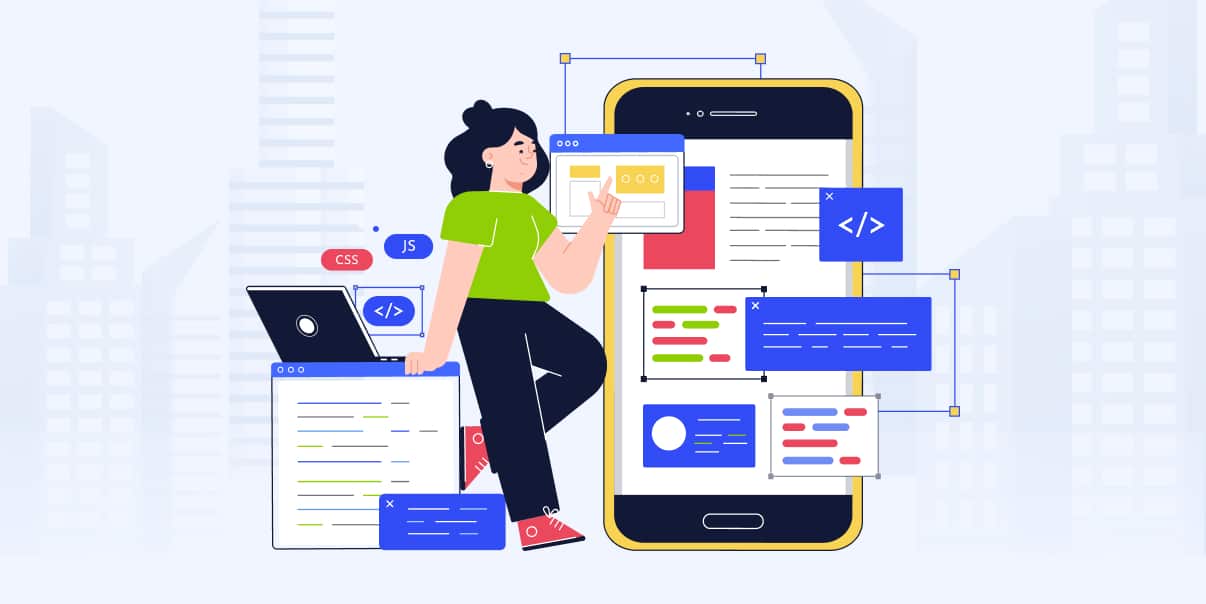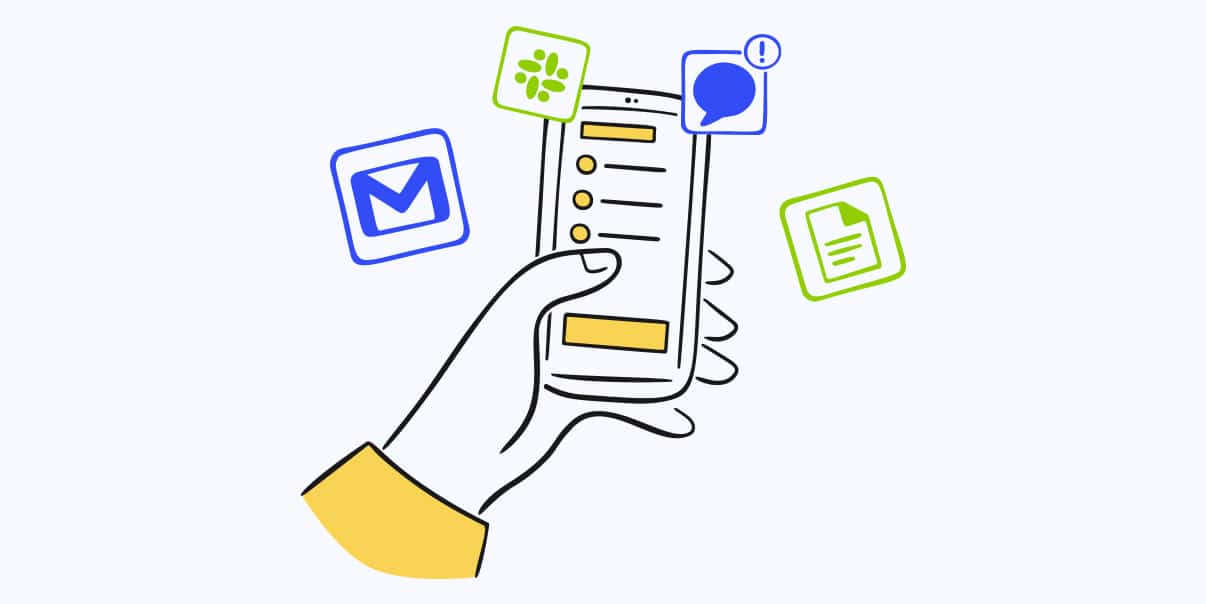Mobile App Development Cost:
A Complete Guide for 2023

Developing a mobile app can be a great way to gain an edge against competitors. However, this can come with a significant price tag.
Mobile app development cost varies from simple apps to complex ones. The cost will depend on the features and functionalities you need. Fortunately, there are ways to reduce your app development price without sacrificing quality.
This article will discuss the factors that can affect your mobile app development cost. We will also tell you the best ways to cut your costs.
Factors That Affect the Cost of Mobile App Development
The cost of your app development will depend on various factors. It is essential to know them before determining the price of the product. Here are some factors that affect your development cost:
Platform
App development for iOS and Android has different costs. You can benefit from both markets, but choosing the best platform for your needs is crucial. You can also reach out to more customers with cross-platform apps after you have made a profit.
Here is the overview of the app development platforms:
iOS
iOS is a system made by Apple exclusively for its products. You can encounter this operating system on devices like the iPhone, iPad, and Apple Watch.
Pros:
- iOS users make more in-app purchases than other operating system users.
- Apple has stricter rules and more rigorous quality control.
- Apple has steady release cycles, which makes it easier for developers to focus on the latest APIs.
Cons:
- It doesn’t have a significant market share compared to Android.
- iOS may not suit businesses that target the global market.
Android
Android has more significant market coverage than iOS. More than 80% of mobile phone users worldwide use this operating system.
Pros:
- It has the highest market share in mobile devices. It can help businesses reach more audiences with Android apps.
- More open-source tools are available to developers. They enable developers to create innovative solutions quickly and cost-effectively.
Cons:
- Developers need to pay attention to different versions of the Android operating system.
Hybrid
A hybrid mobile app combines web-based and native technologies in software. It uses the same codebase for Android and iOS. So, its development process is quicker and has a lower cost.
Pros:
- It is more cost-effective than native apps. With hybrid mobile apps, you don’t need to create separate versions for iOS and Android.
- Hybrid apps can also be a great marketing tool, allowing businesses to target both platforms with one app.
Cons:
- The user experience might not be as good as with native apps.
Complexity of App
The complexity of an app affects its cost as well. Mobile apps range from simple ones with basic features to complex ones that require multiple functions and features. An app with more complexity will incur higher development costs.
Features
The cost of developing a mobile app will depend on its features. Building simple apps with basic features requires less time and effort. Meanwhile, more complex apps take longer to develop and are more expensive.
Naturally, an app that requires more time and skills will cost more. The more features an app has, the greater its development cost.
Some examples of costly features include:
- Augmented reality,
- Location tracking,
- Push notifications,
- Animations,
- Artificial intelligence,
- Third-party integrations
- Portrait or landscape view,
- In-app purchases,
- User login
Design
The cost of your app development project depends on its design and functions. To make an app that works well, you must ensure it’s easy for users to use and that all the functions work correctly. Some apps require more time and money because they have more parts.
Here’s what you need to consider regarding app designs:
- UI/UX Design. It is essential to make some effort for the look and feel of an app. Mobile software developers must think about how users will interact with the app. They need to create a user interface (UI) that is easy for people to use the app. These factors can determine the development cost.
- Custom Mobile App Design. If you want a custom design, then the cost of app development will be higher. Mobile app developers have to create designs from scratch, which makes the process longer and more expensive.
Development Team
Your development team can affect the app development cost. If you hire more skilled and experienced developers, paying them at a higher rate makes sense. The price will also vary if you hire an in-house team or outsource the project.
- In-house Team. Hiring an in-house team means you have complete control over the process. You can also ensure app quality by monitoring progress. But, it comes with a higher cost as you have to pay salaries or other compensation.
- Outsourced Team. If you want to save money, then outsourcing is a great option. It offers you a bigger pool of experienced software developers. Hiring an outside team rather than training in-house personnel will help you finish your project faster.
Location
The location of the app development team also affects the cost. Mobile app developers in countries in Asia and other developing nations usually charge lower rates. You can decide if you will hire onshore or offshore developers.
- Onshore. You can find onshore mobile app development teams in the same country as you. They can be more expensive, especially if you live in US or Europe. But it may also be a better choice for complex projects that require full-time collaboration.
- Offshore. Meanwhile, offshoring means hiring mobile app development teams from other countries. This process is usually more cost-effective than hiring local developers. Most offshore developers offer competitive rates that may be lower than your local hires.
App Maintenance Costs:
You must also consider software maintenance costs when developing a mobile app.
Apps need regular updates to continue functioning properly and meet users’ needs. Updates and maintenance can be costly as developers must handle bug fixes. They also need to ensure the app works across different devices and platforms.
Here are things to consider after deploying your app:
- Hosting. The price of an app’s hosting can affect how much an app costs. Larger apps use more server space and require more hosting, which increases costs. Additionally, features with frequent updates will typically use more server resources.
- Monitoring. This process can also have an impact on the app development cost. Companies need to track performance and usage trends to ensure flawless user experiences. Monitoring requires extra resources and tools, which can increase the development cost. Additionally, detailed real-time data monitoring may need costly tools and services.
- Engagement and Marketing. Aside from monitoring, your app’s engagement and marketing can affect how much it costs. Companies need to work on getting users interested in the app and making sure enough people see it. You may need to spend money on marketing tools and services. Also, you can hire experts or agencies specializing in engagement and marketing.
- App Updates. The cost of app development may increase when a company releases updates. The developers must check and adjust the code to work with new operating systems. They may also have to fix any bugs or security problems, which takes time and money. Companies might also develop or improve new features, adding extra cost.
Licenses
When a company is building an app, it might need to use technology from another company. To do this, the app developer must get permission from the other company and may have to pay fees or royalties. You need to add these extra costs to your software development budget.
Security
Security is a top priority for any app development project. Your mobile app developer has to incorporate security features into their apps. You also need to use security tools and technologies when building the app. Additionally, your app may need to get certifications or licenses as well. These things will add up to your development costs.
Hidden App Development Costs
Aside from the factors above, there are hidden development costs that you should keep in mind. Mobile app developers may incur other expenses, such as:
- Legal fees for contracts, patents, copyrights, and trademarks
- Testing fees for making sure your app functions correctly
- App Store submission fees when listing your app on different platforms
To avoid not having enough budget for these hidden costs, make sure you consult with professionals and your project manager.
Cost of Mobile App Development
So how much does it cost to build mobile apps?
The cost of creating a mobile app depends on its features and design. Simple apps generally cost less, while complex ones can get more expensive. This is because developing applications with more features takes more time and effort.
Aside from skills, the development team must use specialized tools and resources. These things can increase the app development cost.
On average, here is the app development cost breakdown for iOS, Android, and Hybrid platforms:
Native iOS App
Native iOS app development services can be expensive, ranging from $10,000 to $150,000. Apple Store also has strict rules and regulations, which makes the mobile app development process more difficult.
- Simple app: $10,000 to $50,000
- Complex app: $50,000 to $150,000+
Native Android App
Native android app development services will cost around $10,000 to $200,000. The range is more comprehensive because Android can run on multiple devices with different specs. Developers need to consider compatibility issues when creating an app for this platform.
- Simple app: $10,000 to $60,000
- Complex app: $60,000 to $200,000+
Hybrid App
Creating a hybrid app is cheaper than developing native apps. Depending on the app’s complexity, it usually costs $5,000 to $150,000. Using existing code libraries and open-source frameworks can further reduce these prices.
- Simple app: $5,000 to $50,000
- Complex app: $50,000 to $150,000+
These estimates are for the development of usual simple to complex mobile applications. The costs can be significantly higher if your mobile application needs more features.
Tips To Reduce Your Mobile App Development Cost
Creating a mobile app is an excellent investment for your business. According to Statista, the global revenue from mobile apps will reach around $613 a billion in 2025. However, developing an app can cost a lot, especially if you don’t know the best practices for reducing development costs.
Lucky for you, here are some ways to reduce your app development cost:
Prioritize Features
The key to reducing app development costs is prioritizing and sticking to certain features. The things you can see on the app, like buttons and screens, take time to create. It means that the more you add, the more it will cost to make your app.
So, start by creating only the core features and add more complex ones later. You can also use a lean approach where you focus on essential elements first. Then you can add extra features in updates or new versions.
Before adding various features to your app, consider what your users need. Do market research and check your competitor’s apps.
Use a Hybrid Platform
As mentioned, choosing the right platform for your app development is essential. Native apps are suitable for high performance and help developers focus on one platform. However, hybrid apps are cheaper and faster to develop. So, they are an excellent option for businesses on a budget.
Cross-platform apps use just one codebase that is cheaper to build and maintain. They are also compatible with multiple platforms, so your app can reach more users.
Outsourcing to an Offshore Team
Outsourcing to an offshore mobile app development team can help cut costs. You can search for app development teams in India, the Philippines, Vietnam, and Ukraine. These countries offer quality services at lower rates than their onshore counterparts.
You can access more professionals familiar with the latest technologies while saving money.
Here are the countries that offer lower development fees:
- India. This country is one of the most cost-effective locations for app development. Mobile app developers in India are experienced and knowledgeable about the latest technologies.
- The Philippines. It ranks second in terms of mobile app development price. App development teams in the Philippines offer quality services at lower rates than in other countries.
- Vietnam. Vietnam is another popular choice for app development. The mobile app development teams here provide competitive rates and fast turnaround times.
- Ukraine. The cost of partnering with mobile app development companies in Ukraine is lower than in other countries. The mobile app development teams here are also well-versed in the latest technologies. You can also find those with experience creating apps for various platforms.
Utilize Open-source Technologies
Open-source technologies are free to use and can greatly reduce mobile app development costs. Developers can use code libraries, frameworks, and tools already available online.
With open-source technologies, developers don’t have to build everything from scratch. Developers also benefit from the tech community as they can get help and advice from other developers.
Use Readymade Software Templates
When you use existing software components, it helps to reduce mobile app development costs. Developers can use code that is already written and tested by someone else. This process makes the development process faster and less expensive.
Here are the websites that offer readymade software templates.
- GitHub. It is a popular platform for open-source software development. You can access code libraries and other resources here to help them create mobile applications faster and cheaper.
- Codeproject. This online resource lets you find code samples, tutorials, and tools. You can also use these resources to create a mobile app more efficiently and cost-effectively.
- CodePen. In this software, you can find templates, tutorials, and other resources for your development project. You can use CodePen to build a mobile app faster with less effort and cost.
- BootstrapMade. An app developer can find readymade software templates in BootstrapMade. They can also access code libraries and other resources to help them build mobile apps faster.
But, you need to remember that readymade software templates can limit your development creativity. So, it’s vital to balance templates and custom code.
Leverage Cloud Platforms
Using cloud platforms allows your mobile app developer to build an app that can easily handle increasing users and data, making it more scalable. Doing so can also help reduce your mobile app cost. Cloud platforms will help your team quickly access data from multiple sources for better app creation.
Cloud-based solutions also provide storage solutions at lower prices than traditional hosting providers.
Plan For Future Growth To Avoid Redesigns
You can reduce your mobile app development costs by planning for the long term. Mobile apps need regular updates to stay competitive in the market. Your app development team must prepare for these updates and ensure the app is future-proof.
Developers should also design flexible apps to add new features or adjust existing ones easily. This way, you won’t have to redo everything when you want to make changes. It will help you save more time and money in the long run.
Utilize Agile Software Development
Agile software development is a process that streamlines the mobile app development process. The agile approach breaks down complex tasks and allows teams to work more efficiently on each job. It helps reduce costs because developers can focus their efforts on specific goals. Your team can more effectively manage app reiterations and modifications using the agile approach.
Create a Minimum Viable Product (MVP)
Creating a minimum viable product can help you manage your app budget. You can create an MVP with the app’s core features and functions, allowing you to test it and get feedback. It helps you refine your app without having to invest in all of the features right away. Also, it allows you to adjust and update the product based on user feedback before launching a full version.
Here are some examples of mobile apps that started with an MVP:
- Uber. Uber began as an app for users in San Francisco. People liked it so much after the initial launch. Then, they added more cities and features to reach more people.
- Instagram. This app began as a photo-sharing app with only a few editing options. As more people started using it, they added even more features. Now, you can use it for editing tools, sharing stories, and messaging your friends.
- Facebook. Facebook started as a basic version of what it is today. It was just a directory of Harvard students, but they added more universities. It eventually became one of the biggest social media platforms in the world!
Top Mobile App Development Trends
Mobile app developers need to stay up-to-date with the latest technologies and trends. Here are some of the top mobile app development trends that you should watch out for in 2023:
Augmented Reality (AR) Apps
Augmented Reality (AR) combines elements from the digital world with a real-world environment. It creates an interactive experience for different industries. People now use it for healthcare, retail, education, and tourism to provide enhanced user experiences.
AR utilizes visuals, music, graphics, and other media to create an interactive app. It helps companies communicate their ideas and products to customers in a fun way.
Here are some examples of AR apps:
- Pokémon GO. This app uses augmented reality to offer a better gaming experience. Here, players can find and catch virtual Pokémon characters in the real world.
- IKEA Place. It is an AR-based shopping app for IKEA consumers. This app allows shoppers to see how the furniture looks in their homes before buying them.
- Layar. This app uses AR to scan physical items and add digital information, such as product reviews or price comparisons.
To create an AR app, you may need an app development budget of $30,000 and $150,000+.
Mobile Commerce (M-commerce)
People are turning to M-commerce to buy and sell goods through mobile devices. Studies show 85 percent of consumers prefer shopping in mobile apps over physical stores. It helps businesses increase their sales and make the buying process easier.
So, it’s essential to have your M-commerce apps easy to use on mobile devices. You can include features like easy login and payment. Also, having an excellent user interface will appeal to customers. Chatbots and augmented reality can also help enhance the customer experience.
Here are some examples of Mcommerce apps:
- Amazon Mobile. This app allows customers to buy products on the go. Customers can quickly pay for their items and track their orders from their mobile devices.
- Walmart Mobile App. Walmart Mobile app makes it easy for customers to shop, compare prices, and pay with their phones. It also offers features like discounts and coupons, which help shoppers save money.
M-commerce apps typically cost around $21,000 to $100,000, depending on their features.
AI-enabled Apps
AI-enabled apps are the latest thing in mobile app development. These apps use Artificial Intelligence to mimic human-like learning and thinking capabilities. They can answer questions, complete tasks, and suggest content based on your target users’ search. AI-enabled apps also help businesses understand and analyze user data.
Here are some examples of AI-enabled apps:
- Siri. Siri is one of the most popular AI virtual assistants. It helps Apple users with tasks like setting reminders, telling jokes, and giving directions.
- Google Assistant. It helps users schedule appointments, find restaurants, and set reminders.
- Amazon Alexa. This voice assistant can answer questions, order products, and play music.
- IBM Watson. IBM’s AI platform helps businesses analyze large datasets and make decisions based on the data.
- Cortana. It is an AI-powered virtual assistant from Microsoft. It helps in setting reminders, checking the weather, and finding directions.
Developing an AI-powered app like Siri and Alexa may cost around $30,000 to 300,000+.
Beacon Technology
One of the latest trends in mobile apps is beacon technology. This technology employs small devices to track users in a specific area. Developing an app with a beacon usually costs between $10,000 – $100,000.
You can also use beacons to send push notifications to customers near your business. They can help you understand customer behavior better. This way, it will be easier to find and reach potential customers.
Here are some industries that use beacon technology for their mobile apps:
- Retail stores can use beacons to send notifications about sales and discounts to people nearby.
- Museums can use them to provide information about exhibits and artifacts.
- Hospitals can use beacons to help patients find their way around the facility.
Blockchain-powered Mobile App
Blockchain technology is the latest way to store data. It’s a secure and transparent way to organize information like digital money or payments.
Unlike in traditional systems, people can’t change the data they store using blockchain. This feature makes it perfect for apps that track payments and transactions. With blockchain technology, businesses can ensure that each transaction is secure and valid.
Here are some examples of blockchain-powered mobile apps:
- CryptoKitties. This app allows users to buy, sell, and breed digital cats using blockchain technology.
- BitPay. Bitpay is a mobile wallet app that stores and transfers cryptocurrencies securely.
Developing blockchain-powered apps may cost you around $60,000-$300,000.
Apps for Wearables
Smartwatches and other wearables are becoming more trendy these days. People use them for health tracking, fitness monitoring, and payments.
So, mobile app developers should create apps compatible with wearables. This way, users can easily access your app features on their devices. To develop apps for wearables, you may spend around $30,000-$150,000.
Here are some examples of wearable apps:
- Fitbit. This app helps people track their health and fitness goals. It measures heart rate, steps taken, calories burned, and other vital signs. Fitbit also has a mobile app that makes tracking progress on the go easier.
- Apple Watch. It is one of the most popular wearables available today. It can help its users track fitness goals, check notifications, and even make payments.
- Samsung Gear. Samsung’s Gear smartwatch is another popular choice for developers. Its features allow users to monitor their heart rate and check notifications. It also allows its users to call people directly from their wrists.
Conclusion
Your mobile app development cost may vary, so understanding the influencing factors is essential. Mobile app developers must stay up-to-date on the latest technologies and trends. It will help them create apps that meet users’ needs.
Following the tips above, mobile app development teams can reduce costs. Also, consider outsourcing your custom mobile app development project to lower-cost countries. You must also plan for long-term growth and avoid costly redesigns.
If you want to outsource your mobile app development needs, BIT Studios can help. Our app development company provides quality services that meet your app development budget. Contact us, and we’ll give you a free estimate for your project.
We’re BIT Studios!
At BIT Studios we specialize in designing, building, shipping, and scaling beautiful, usable products with blazing-fast efficiency



